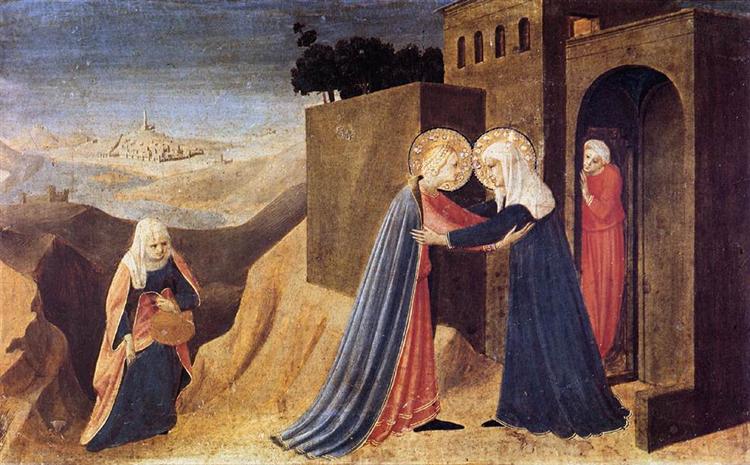The Feast of the Visitation commemorates the visit of the Blessed Virgin Mary to her cousin Elizabeth while both of them were pregnant (Mary with Jesus, and Elizabeth with John the Baptist). It is traditionally celebrated on July 2; in the Novus Ordo it is on May 31. There is a wealth of meaning in the events that took place during the Visitation. The Bible says:
In those days Mary arose and went with haste into the hill country, to a city of Judah, and she entered the house of Zechariah and greeted Elizabeth. And when Elizabeth heard the greeting of Mary, the babe leaped in her womb; and Elizabeth was filled with the Holy Spirit and she exclaimed with a loud cry, “Blessed are you among women, and blessed is the fruit of your womb! And why is this granted me, that the mother of my Lord should come to me? For behold, when the voice of your greeting came to my ears, the babe in my womb leaped for joy. And blessed is she who believed that there would be a fulfillment of what was spoken to her from the Lord.”
– Luke 1:39–45
The Joy of John the Baptist, who was an Unborn Child
As mentioned above, the child in Elizabeth’s belly was John the Baptist. As all the prophets of the Old Testament had done, John prophesied that the Messiah would come (John 1:19–28), and one day, when he saw Jesus coming toward him, John told the people, “This is the Messiah” (John 1:29–34). For this reason, John is known as the last prophet of the Old Testament.
According to the traditional interpretation, the unborn John, who was a prophet, danced for joy when he realized that Jesus, the unborn child in Mary’s womb, was the Messiah.
Ave Maria
The words that Elizabeth, filled with the Holy Spirit, said to Mary are part of the most fundamental Catholic prayer to the Blessed Virgin: the “Ave Maria,” or “Hail Mary.”
Ave Maria, gratia plena, Dominus tecum.
Benedicta tu in mulieribus, et benedictus fructus ventris tui Jesus.
Sancta Maria, Mater Dei,
Ora pro nobis peccatoribus, nunc, et in hora mortis nostrae.
Amen.
Hail Mary, full of grace,
The Lord is with thee.
Blessed art thou among women,
And blessed is the fruit of thy womb, Jesus.
Holy Mary, Mother of God,
Pray for us sinners, now and at the hour of our death.
(The bolded portions were added in the 16th century.)
The Gospels were written in Koine Greek. Koine Greek was the common language of the Roman Empire, and would have been used by Jews in public, and when talking to Gentiles. Elizabeth, however, probably greeted Mary in Aramaic, the native language of the Palestinian Jews at that time, and the language that they would probably have used among themselves in their homes.
In the following video, we can hear the Ave Maria, Schubert version.
Friar Alessandro
Mary’s words: Magnigicat
Mary’s words to Elizabeth are found in Luke 1:46-55, and are called the Magnificat. The Magnificat is traditionally sung at Vespers (Evening Prayer), which is usually said at around the time of sunset. Here is a portion of it:
My soul magnifies the Lord,
and my spirit rejoices in God my Savior,
for he has regarded the low estate of his handmaiden.
For behold, henceforth all generations will call me blessed;
for he who is mighty has done great things for me,
and holy is his name.”
– Luke 1:46–49.
The Canticle of Zechariah
After the Canticle of Mary at Vespers, the Canticle of Simeon (Luke 2:29–32) is sung at Compline (the prayers said before bedtime); then, around sunrise, the Canticle of Zechariah (Luke 1:68–79) is sung at Lauds (Morning Prayer). The following is a portion of it:
Blessed be the Lord God of Israel,
for he has visited and redeemed his people,
and has raised up a horn of salvation for us
in the house of his servant David,
as he spoke by the mouth of his holy prophets from of old,
that we should be saved from our enemies,
and from the hand of all who hate us;
– Luke 1:68–71.
Traditional Irish Marian Hymn from an old book
July 2 this year was a Sunday, but the parish priest, in his homily at Mass, did not speak specifically about Mary’s visit to Elizabeth. This is not surprising, since most parish priests preach according to the Novus Ordo calendar. Even so, I felt somewhat sad that there was nothing said about the traditional calendar, even though it was a Feast Day of the Blessed Virgin Mary.
After Mass, as usual, I stopped by the small book corner in the church. The church’s book corner has a lot of used books that seem to have been left behind from bygone times, and you can borrow them at your leisure.
As I was pulling out a few books to borrow, I noticed, in an inconspicuous place, a book with a red spine and a picture of a medieval-style woman. I picked it up and took a closer look. The woman pictured on the spine was Saint Lucy—one of my patron saints! Intrigued, I opened the book, titled My Nameday—come for Dessert, by Helen McLoughlin.
The page I happened to open to was the page for July 2, The Visitation, with a recommended hymn. The hymn had a simple, rustic charm not found in modern music.
It makes me happy to think that God introduced this song and prayer to me through my Patron Saint, on one of Mary’s Feast Days.
Oh Mary of Graces, a quiet prayer melody
The hymn was originally a traditional Irish Gaelic folk song. The traditional Irish singing style was a cappella, with no instrumental accompaniment, and the song was sung with eyes closed as the story was told and sung.
This short but beautiful song was translated from Gaelic into English and is called “Oh Mary of Graces.” The quiet melody of the original song has a haunting, prayerful melancholy. My impression of this piece was that someone who had suffered a tragedy was praying to the Virgin. At the same time, one can feel in it the strength of a person who, instead of lamenting his own misfortune, tries to overcome it through prayer.
Although not sung in traditional Gaelic, Jonas Eklund’s video fits the mood of the song perfectly. The girl sings in a clear voice at a relaxed tempo, accompanied by a simple guitar accompaniment.
I pray that this beautiful prayer and hymn to the Blessed Virgin will not be forgotten, but will be passed on to future generations.
Source: McLoughlin, Helen. My Nameday–Come for Dessert. Collegeville, MN: The Liturgical Press, 1962.

